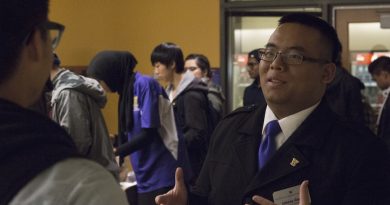Opinion: ASUWT went about moving the Center for Equity and Inclusion the wrong way
Why has ASUWT chosen Tioga as its Alamo?
I recently witnessed President Dubad’s demonstration to relocate the Center for the Equity and Inclusion to the top floor of the Tioga Library. The purpose of her actions was to draw attention to their cause and ASUWT’s grievances with the university administration — including Chancellor Mark Pagano.
The administration responded by giving the student government what they wanted, but the friction was apparent. Will it remain?
Located in WCG 102, the Center is housed in multiple rooms just across from West Coast Grocery. While the current space is rather cramped, the three other proposals — offices in the Mattress Factory building, a larger and reconfigured area in WCG or the top floor of the Tioga building — are all comparably larger and places the office in areas that are both accessible to the student body and close to other faculty departments.
ASUWT and other student leaders have been adamant about the Tioga location as it provides a new and much larger space than the other two options. ASUWT claims that Chancellor Pagano has been hesitating to commit to the Tioga location. The chancellor set the moving date for fall 2018. This irked ASUWT as it set back the timeline that they desired and appeared to be stalling the transition altogether.
The reality of the situation is that Pagano was waiting for a new assistant chancellor of Equity and Inclusion to take their position, as there is currently an interim director while a new one is selected by the university administration. If Chancellor Pagano hesitated, it was to include that person’s input, and to avoid the appearance of overreach by the current administration — which could bring further suspicion or friction from ASUWT.
The donation of these large office spaces by the university administration — that day, during the protest — seems contrived and rushed in an attempt to avoid further controversy. ASUWT, while completely in their rights to discuss the delay of the Center’s transition and their lack of input on the issue, made the unnecessary act to publicly protest. This exposed an over-dramatic if not desperate desire for action — and strained their relationship with university administrators in the process.
The other spaces being more strategically located in buildings with already existing office infrastructure. However, ASUWT seems attracted to the large undeveloped spaces of the library. It would make for a symbolic gesture by the university — a larger location for the Center appears to gauge the university’s interest in creating a space that values the equity and inclusion of its students.
While an understandable action, the protest by the ASUWT seemed rushed and created an atmosphere of separation with regards to the relationship between it and the university administration. Furthermore, if Pagano had made the decision to move the Center to the library without the input of a new assistant chancellor, the decision would seem rushed and lack input from the very organ that is the center of this campus-wide conversation. Someone or something has to provide a compromise for this transition to go smoothly.
The current offices of the Center for Equity and Inclusion are smaller than what they should be, and they deserve a relocation to an office that will suit their needs better. I completely agree with the ASUWT that a new office should have been designated before this became a public issue. ASUWT should have also had some significant input before the decision was made.
But the method by which the administration’s attention was caught — a public protest — created a tense atmosphere between ASUWT and the campus administration, and left Chancellor Pagano little option to debate or decline immediate action over the issue. The protest was created to force a response rather than consider any other options — something that any student government should steer clear from. Not to mention, the use of coarse language towards Chancellor Pagano and other members of the campus administration was unjust and made the actions taken by the ASUWT appear hostile. It represents a high-handed overreaction which only corrodes the legitimacy of the ASUWT and their ability to play well with the campus administration.







